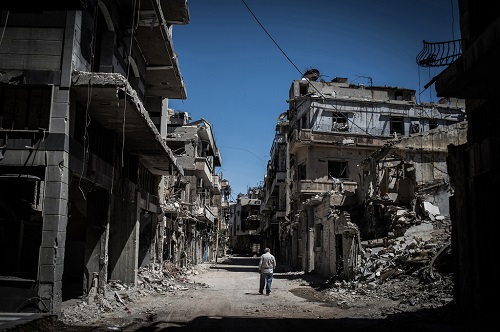Chaoyue Pan photo
By
Dan Marshall-Singh
Terrorism is the activity of producing terror or fear in people, however defining terrorism can be difficult. Acts of terrorism can include domestic terrorism; lone wolf terrorism; and religious terrorism.
With the global landscape changing, the line between terrorism and acts of violence is becoming blurred, as is the reasoning and causes of committing terrorist activity. But, how can climate change be a catalyst?
Case Study: The Arab Spring
The Arab Spring (also known as The Arab Revolution) was a movement of violent and non-violent demonstrations, protests and riots starting in 2010, which spread across the Middle East and North Africa.
In this largely dry desert region, farmland is scarce and imports from Western European countries are limited. Syria for example is roughly the size of Spain, but only about a quarter of its 185,000 square kilometres is arable land – around the same size of Switzerland. Most is desert, some is suitable for grazing, but less than 10 percent is permanent cropland (1). The Middle East and North African region’s share of greenhouse gases does not exceed that of its more developed neighbours, however it is among the regions that have been most adversely affected by the consequences of climate change so far, and droughts and desertification are already causing a decline in agricultural production and falling water levels in rivers and seas.
After a widespread drought across Syria and the Arab states from 2006-2010 caused crops to fail, thousands of farmers poured into nearby cities hoping to find work, which put immense strain on local services. Some found jobs as road sweepers and food vendors, however many did not find employment and became homeless and moved further into poverty. Unsatisfied with the national government’s help, a local group staged a protest in the small city of Daraa in 2010. Under Syria’s President Bashar al-Assad’s orders, this was met with the full force of the army, leading to riots breaking out across the city and eventually spreading over the entire country (2). This lead to the ongoing Syrian Civil War.
What is climate change?
According to NASA, “Climate change is a change in the usual weather found in a place. This could be a change in how much rain a place usually gets in a year. Or it could be a change in a place’s usual temperature for a month or season. Climate change is also a change in Earth’s climate. This could be a change in Earth’s usual temperature. Or it could be a change in where rain and snow usually fall on Earth” (3).
We know climate change is not something that can happen overnight, however the effects of climate change can change the lives of people very quickly.
Dan Marshall-Singh
As a recent graduate of Mandarin Chinese and International Relations, Dan’s specialist knowledge included contemporary Chinese studies, terrorism and conflict, international relations of South East Asia and Mandarin language. Having spent long periods in China and Hong Kong and working closely with the Chinese community in the UK, Dan hopes to emigrate to Hong Kong in the near future to further his knowledge in Chinese culture and society.
1 William R. Polk, theatlantic.com, [last accessed – 16th November 2017]
2 William R. Polk, theatlantic.com, [last accessed – 16th November 2017]
3 Sandra May, nasa.gov, [last accessed – 20th November 2017]



No Comments Yet!
You can be first to comment this post!